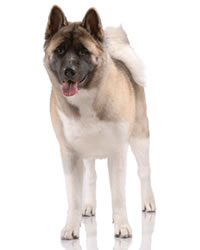Akita Dog Breed Information
 |
| ||||||||||||||||||||||||||||||||||||||||||||||||||||||||||||||||||||||||||||||||
Akita Dog – Just The Facts
| Do you own this Dog breed?Please tell us about it in the form at the bottom of this page. Need a good Puppy Name?Visit our Puppy Names page for 1000s of top dog names. |
General Description
The Akita dog may be the answer to your search for a watch dog and protector that doesn’t annoy you with excessive barking. Their wolfish face, curled tail and quiet, dignified presence are enough to scare off intruders from your property. Raise one in your home today, and experience the thrill of owning a revered canine developed by Japan’s very own samurais.
Origin and History
Akita Prefecture in Japan is home to the breed. There are tombs dated in the 17th century that feature drawings of the dogs.
Some documents attribute the breeding work to samurais, while others say that an exiled nobleman is actually responsible for the emergence of the Akita dog.
The early dogs fought bears, hunted boars, retrieved water fowls and even served as imperial guards! In the 18th century, Akitas became established fighting canines.
Drop the name “Akita” in Japan, and you will generate knowing and reverent nods. You see, the land of the rising sun designated the breed as one of its national treasures in 1931.
Today, a huge number are involved in police work, but this doesn’t mean you can’t have an Akita dog for a pet.
Akita Dog Temperament
Particular about making their loyalty known, these dogs are generally demonstrative of their affection to family members but cold and aggressive towards strangers, smaller pets and other canines of the same sex.
Caveat: No matter how much the dog bonds with you, don’t try to sustain eye contact and interact with an Akita during meal time. The breed is extremely sensitive to challenges and protective of its food supply. It will snap and bite if disturbed!
Care, Grooming, Diet & Exercise
Living Environment – With zero tolerance for heat and maximum forbearance for the cold, the breed is fit to live in the earth’s cooler regions only. It can make the chilly outdoors its home, but it prefers to sleep indoors with you.
The Akita’s active disposition in and out makes a large, securely fenced yard a necessity. As much as possible, you should prevent the breed from coming into contact with strangers, animals and other creatures whom it might attack.
Grooming – This dog breed is a heavy shedder, and this means that even when you only have to brush the dog’s coat at least once a week, you’re still expected to do a lot of vacuuming. Heavy shedding periods can last for weeks – at least once or twice a year.
Their webbed foot hairs require trimming, too. To preserve the water resistance property of its coat, shampoo and bathe the dog only when necessary.
Diet & Exercise – Akitas are accustomed to an Asian fare of fish, rice and some sea vegetation. To put a leash on possible obesity problems, limit the servings to two in a day. Exclude onions at all costs, as these are known to cause alterations in the breed’s red blood cells.
Balance is essential, so couple the feedings with physical exercises and mental challenges. Nothing strenuous is required. Your pooch will savor long walks or extended off-leash play in your well-fenced yard.
Health – In the health department, these dogs aren’t totally hardy as they look. Many are plagued with gastric torsion, which can turn out be fatal. A number succumb to chronic heart diseases, skin conditions (and not just allergies) and progressive renal atrophy.
Akita Dog Trainability
The breed is surprisingly easy to housebreak, but don’t even think of sending your Akita dog to obedience classes. Its domineering nature requires the leadership of one confident and seasoned pet owner: you and only you.
Early and adequate socialization, as well as avoidance of harsh methods, will prove beneficial to the entire process. These steps will downplay defensive biting and indiscriminate recognition between friend and foe.
Do you own this dog breed?
Please tell us about your experience with a particular dog breed, and upload a picture if you have one!
Return to AKC List of Dog Breeds ranked by Popularity
Return from Akita Dog back to Alphabetical List of Dogs Breeds page